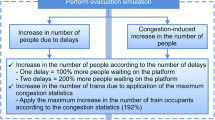Abstract
Developments of urban areas must consider mass transportation of people generated by economic activities and their impact on public safety. Fire remains a great challenge for the city’s planner as its occurrence in crowded and busy areas could result in a fire disaster. A fire disaster in a mass public transportation system could cause serious impact due to the number of people involved. During design stage of new mass rapid transit lines, the walking characteristics of the local passengers should be greatly considered. This paper critically analysed passenger movement at the three busiest commuter line stations in Jakarta. The survey was carried out during the peak hours both in the morning and in the evening. It is observed that the walking speed of the passenger was affected by density at various locations measured on the platform and concourse levels as well as at the ticket gates. The corresponding value of the specific flow was also derived to frame the average value that could be considered during the design stage of a new line. In general, the study shows that both the average walking speed and the specific flow of the local passengers are slightly lower than the average value given in the international standards such as NFPA 130 (USA) and MLIT (Technical Standard Requirement for Japan Railway).
Access this chapter
Tax calculation will be finalised at checkout
Purchases are for personal use only
Similar content being viewed by others
Abbreviations
- D :
-
Density (person/m2)
- W e :
-
Effective width (m)
- F s :
-
Specific flow of crowd outflow (person/m/s)
- S :
-
Walking speed of crowd (m/s)
References
Local Government Regulation of Daerah Khusus Ibukota Jakarta Number 1/2012 on Jakarta Masterplan (Rencana Tata Ruang Wilayah) 2030
Building Act of Indonesia Number 28/2002
Fruin (1971) Pedestrian planning and design, p 215
Proulx G (2002) Movement of people: the evacuation timing. In: SFPE handbook of fire protection engineering, 3rd edn. National Fire Protection Association Quincy, Massachusetts and Society of Fire Protection Engineers Bethesda, Maryland, pp 3.342–3.366
Galea ER, Deere S, Sharp G, Filippidis L, Hulse L (2010) Investigating the impact of culture on evacuation behaviour. In: Proceedings of the 12th international fire science & engineering conference, University of Nottingham, UK
Stubenschrott M, Kogler C, Matyus T, Seer S (2014) A dynamic pedestrian route choice model validated in a high density subway station. Transp Res Procedia 2:376–384
Wu G-Y, Chien S-W, Huang Y-T (2010) Modeling the occupant evacuation of the mass rapid transit station using the control volume model. Build Environ 45:2280–2288
Morita Y, Morichi S, Ito M (2014) A study on coordination between urban development and station capacity, Case Studies on Transport Policy 06
National Fire Protection Association, NFPA 130: standard for fixed guideway transit and passenger rail systems, 2000 Edition
MLIT-Technical standard requirement for Japan railway and explanation of fire prevention standards for underground stations, pp 361–368
Acknowledgements
The authors would like to thank Pemerintah Daerah Khusus Ibukota Jakarta, Indonesia, and Dinas Penanggulangan Kebakaran dan Penyelamatan for providing scholarships to Mr. Sakti and Ms. Leonita as well as the support from PT KCJ Jakarta during the data collection and discussion.
Author information
Authors and Affiliations
Corresponding author
Editor information
Editors and Affiliations
Rights and permissions
Copyright information
© 2017 Springer Science+Business Media Singapore
About this paper
Cite this paper
Sakti, H., Leonita, F., Santoso, M.A., Nugroho, Y.S. (2017). Analysis of Commuter Line’s Passenger Movement in the Station During Peak Hours. In: Harada, K., Matsuyama, K., Himoto, K., Nakamura, Y., Wakatsuki, K. (eds) Fire Science and Technology 2015. Springer, Singapore. https://doi.org/10.1007/978-981-10-0376-9_15
Download citation
DOI: https://doi.org/10.1007/978-981-10-0376-9_15
Published:
Publisher Name: Springer, Singapore
Print ISBN: 978-981-10-0375-2
Online ISBN: 978-981-10-0376-9
eBook Packages: EngineeringEngineering (R0)




